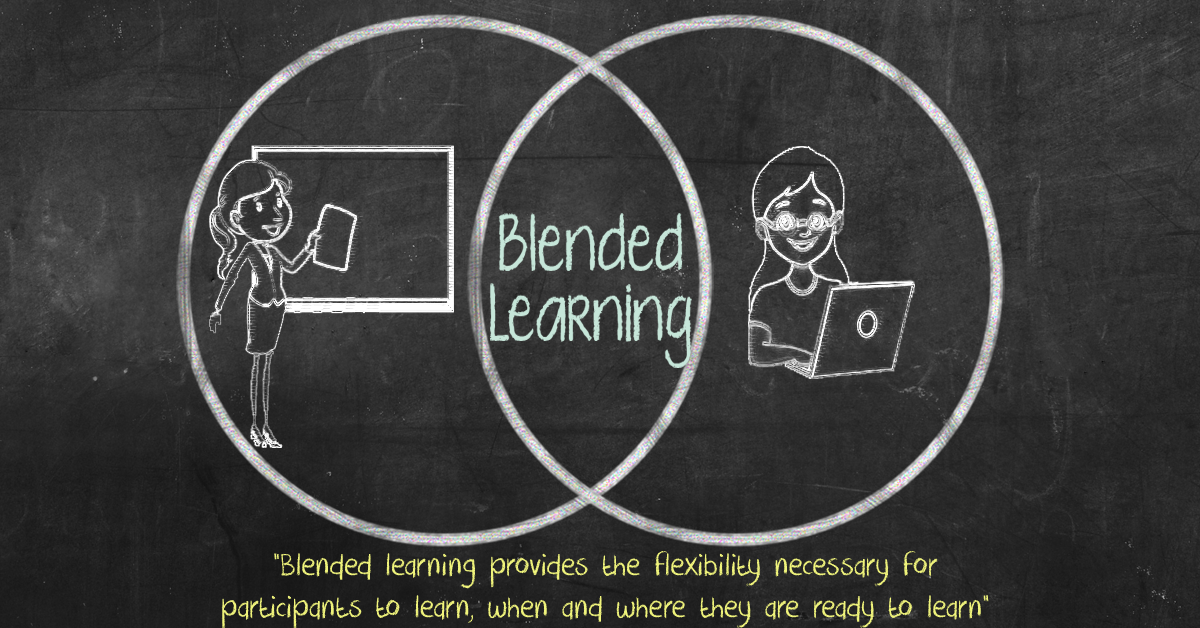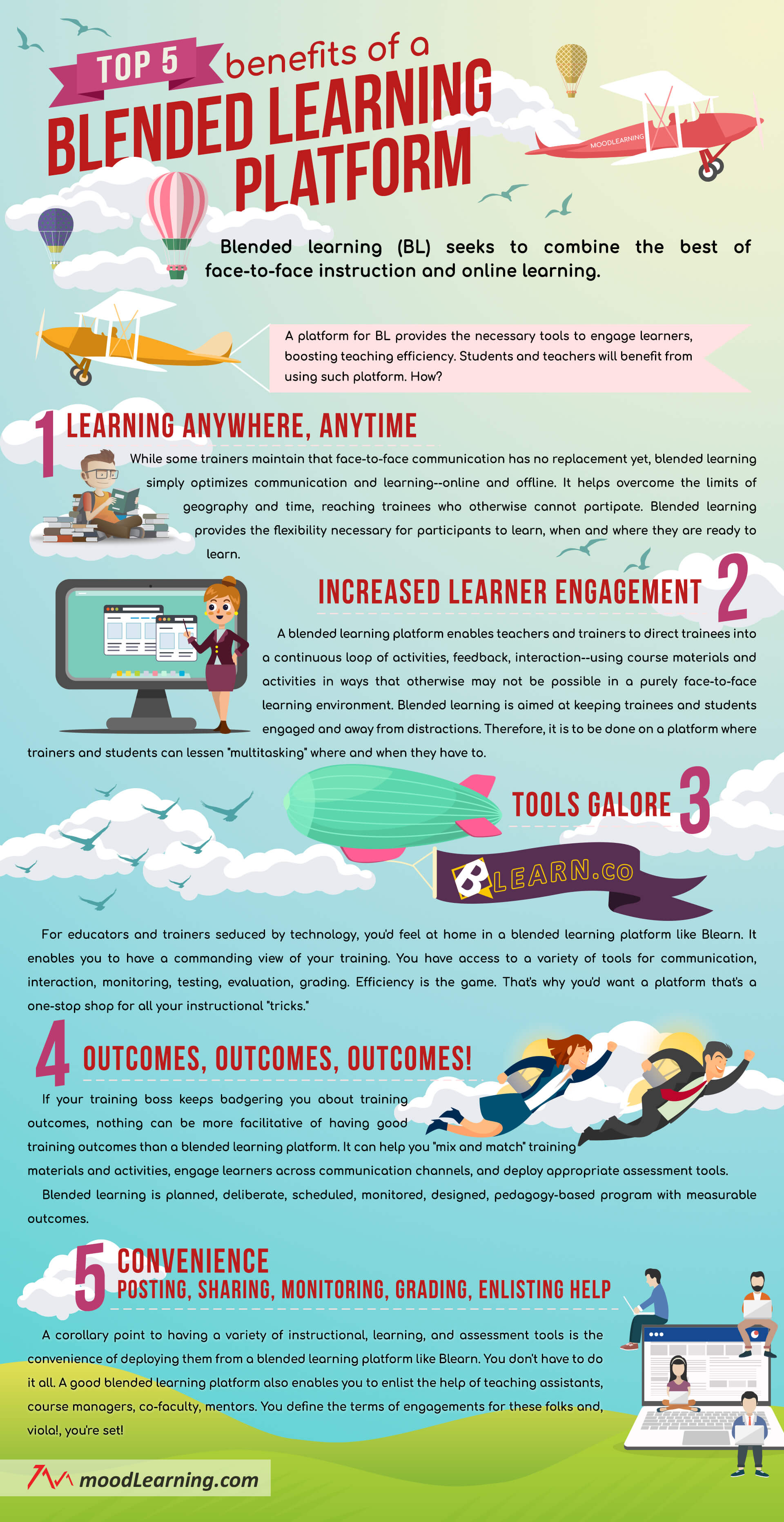Top 5 Benefits of a Blended Learning Platform

Blended learning (BL) seeks to combine the best of face-to-face instruction and online learning. Arguably it's the best there is in state-of-the-art education! “…[In] studies contrasting blends of online and face-to-face instruction with conventional face-to-face classes, blended instruction has been more effective” (US Dept of Education, 2010).
A platform for BL provides the necessary tools to engage learners, boosting teaching efficiency. Students and teachers will benefit from using such platform. How?
1. learning anywhere, anytime
Unlike purely face-to-face training or instruction, blended learning takes place without having to haul people into one hall and keep them there for a long time. That works specially well for companies with personnel all over the country whose time is limited and will have to "mind the store" just the same. Or even if your staff are all in close locations in a region, you'll have to contend with non-learning matters like traffic jams and being away from family for an extended period. Think of loss of productivity, just for the commute or for your employees to wade through traffic.

While some trainers maintain that face-to-face communication has no replacement yet, blended learning simply optimizes communication and learning--online and offline. It helps overcome the limits of geography and time, reaching trainees who otherwise cannot partipate. Blended learning provides the flexibility necessary for participants to learn, when and where they are ready to learn.

The choice is not between work and learning; both are inextricably linked. A blended learning platform affords people to accomodate both, at times of a learner's choosing. All these are happening in one virtual place (accessible from virtually anywhere): a blended learning platform.
2. increased learner engagement
With all distractions online and offline, engaging learners and trainees can be a major challenge. But coordinating learning from a single platform and incorporating otherwise distracting channels into the course could well increase learner engagement. A blended learning platform enables teachers and trainers to direct trainees into a continuous loop of activities, feedback, interaction--using course materials and activities in ways that otherwise may not be possible in a purely face-to-face learning environment.
Blended learning is aimed at keeping trainees and students engaged and away from distractions. Therefore, it is to be done on a platform where trainers and students can lessen "multitasking" where and when they have to. For certain learning tasks, students have to remain engaged, so as not to reduce their ability to filter out interferences (Ophir et al, 2009).
For learning to take place, you have to be in the mood for it and be engaged on the levels of both the intellect and the affect.
3. tools galore
For educators and trainers seduced by technology, you'd feel at home in a blended learning platform like Blearn that enables you to have a commanding view of your training. If you're not into technology (yet!), yield to a little tech temptation.

In such tech platform, you have access to a variety of tools for communication, interaction, monitoring, testing, evaluation, grading. In blended learning, efficiency is the game. That's why you'd want a platform that's a one-stop shop for all your instructional "tricks."

4. outcomes, outcomes, outcomes!
If your training boss keeps badgering you about training outcomes, nothing can be more facilitative of having good training outcomes than a blended learning platform. It can help you "mix and match" training materials and activities, engage learners across communication channels, and deploy appropriate assessment tools.
Blended learning is planned, deliberate, scheduled, monitored, designed, pedagogy-based program with measurable outcomes.

Most of all, it makes learning ACTIVE! By that I mean, in most cases, the use of group activities that reinforce learner initiatives and foreground the "game" and fun aspects of learning. Group activities done through a blended learning platform can highlight simultaneously the cooperative and competitive spirits of student peers.
Let me just reproduce here a single graph from a study that shows active learning increases student performance:

Clearly active learning keeps students engaged, at least among the STEM (science, technology, engineering, math) crowd. Its advantage over mere lecturing (in terms of pass/fail outcome) is at least 10 per cent! Complementing learning with online activities through a platform is a logical extension in making learning "active."
5. convenience - posting, sharing, monitoring, grading, enlisting help
A corollary point to having a variety of instructional, learning, and assessment tools is the convenience of deploying them from a blended learning platform like Blearn. Already instructors or trainers are saddled with mixed concerns (learning-related or otherwise). They cannot be expected to "hug it all." Hence, what you need is a platform that consolidates the delivery of lessons, sharing them accross channels, monitoring students' use of course materials and participation in various training activities, and assessing students. Such platform lightens otherwise burdensome tasks of teaching and mentoring.

You don't have to do it all. A good blended learning platform also enables you to enlist the help of teaching assistants, course managers, co-faculty, mentors. You define the terms of engagements for these folks and, viola!, you're set!
